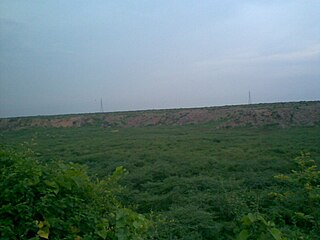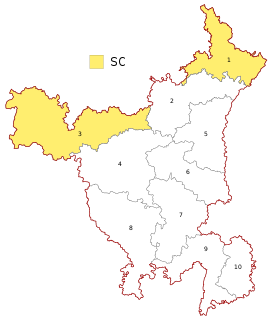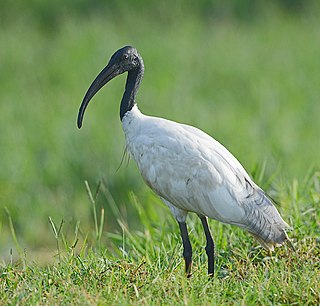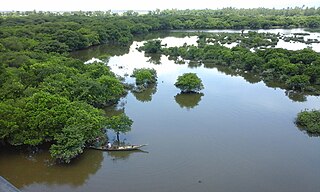
Sultanpur National Park is located at Sultanpur village on Gurugram-Jhajjar highway, 15 km from Gurugram, Haryana and 50 km from Delhi in India.

Badkhal Lake was a natural lake situated in Badkhal village near Faridabad, built in 1947 in the Indian state of Haryana, about 32 kilometers from Delhi. Fringed by the hills of the Aravalli Range this was a man-made embankment. Owing to unchecked mining in neighbouring areas, the lake has now totally dried up. There are functional Haryana Tourism restaurants in the vicinity. A flower show is held every spring here. Its name is most probably derived from the Persian word bedakhal, which means free from interference. Close to Badkhal Lake, is the Peacock Lake, which is another picturesque spot. It is an important biodiversity area within the Northern Aravalli leopard wildlife corridor stretching from Sariska Tiger Reserve to Delhi. Historical place around sanctuary are the 10th century ancient Surajkund reservoir and Anangpur Dam, Damdama Lake, Tughlaqabad Fort and Adilabad ruins, Chhatarpur Temple. There are several dozen lakes formed in the abandoned open pit mines in and around the sanctuary. It is contiguous to the seasonal waterfalls in Pali-Dhuaj-Kot villages of Faridabad, the scared Mangar Bani and the Asola Bhatti Wildlife Sanctuary.

Hisar Lok Sabha constituency is one of the 10 Lok Sabha (parliamentary) constituencies in Haryana state in northern India. This constituency covers the entire Hisar district and parts of Jind and Bhiwani districts.

The Najafgarh drain or Najafgarh nalah, which also acts as Najafgarh drain bird sanctuary, is another name for the northernmost end of River Sahibi, which continues its flow through Delhi, where it is channelized, and then flows into the Yamuna. Within Delhi, due to its channelization for flood control purposes, it is now erroneously called "Najafgarh drain" or "Najafgarh nullah." It gets this name from the once famous and huge Najafgarh Jheel (lake) near the town of Najafgarh in southwest Delhi and within urbanized Delhi. It is the Indian capital’s most polluted water body due to direct inflow of untreated sewage from surrounding populated areas. A January 2005 report by the Central Pollution Control Board classifies this drain, with 13 other highly polluted wetlands, under category ‘‘D’’ for assessing the water quality of wetlands in wildlife habitats.
Najafgarh Lake, Najafgarh Marsh or Najafgarh Jheel, fed by Sahibi River, used to be a vast lake in the south west of Delhi in India near the town of Najafgarh from which it takes its name. It was connected to the river Yamuna by a natural shallow nullah or drain called the Najafgarh nullah. However, after the 1960s the Flood Control Department of Delhi kept widening the Najafgarh drain in the pretext of saving Delhi from floods and eventually quickly drained the once huge and ecologically rich Najafgarh lake completely. Rainwater accumulating in the Najafgarh lake or jheel basin had been recorded to have occupied more than 300 square kilometres (120 sq mi) in many years before its unfortunate draining.

Najafgarh drain bird sanctuary(proposed)and wetland ecosystem is composed of the wetland ecosystem and wildlife habitat on several kilometres of the Najafgarh drain or nullah which passes through rural southwest Delhi in India's capital territory. It includes the portion draining the depression or basin area that formed the once famous but now completely drained Najafgarh lake or Najafgarh jheel.

Asola-Bhatti Wildlife Sanctuary covering 32.71 sqkm area on the Southern Delhi Ridge of Aravalli hill range on Delhi-Haryana border lies in Southern Delhi as well as northern parts of Faridabad and Gurugram districts of Haryana state. Biodiversity significance of Ridge lies in its merger with Indo-Gangetic plains, as it is the part of the Northern Aravalli leopard wildlife corridor, an important wildlife corridor which starts from the Sariska National Park in Rajasthan, passes through Nuh, Faridabad and Gurugram districts of Haryana and ends at Delhi Ridge.
Chhawla or Najafgarh drain city forest consists of forestry plantations near the town of Chhawla on both embankments of Najafgarh drain, which is the delhi-end of Sahibi River originating from Aravalli range mountain in Rajasthan, flowing along the border of Haryana state and south west Delhi in India before confluencing with Yamuna. It provides refuge to local and migratory wildlife specially waterfowl and other water birds. The area is a subset of the entire Najafgarh drain in rural south west Delhi with forested plantations on both its embankments which has been proposed as the Najafgarh drain bird sanctuary.
Bhalswa Horseshoe Lake, or Bhalswa Jheel, is a lake in northwest Delhi, India. It was originally shaped like a horseshoe. However, over the years half of it was used as a landfill area. Now a low income housing colony, an extension of the nearby town of Bhalswa Jahangir Puri has been built on it, destroying the once excellent wetland ecosystem and wildlife habitat of the region which once played host to scores of local and migratory wildlife species, especially waterbirds, including waterfowl, storks and cranes. This horseshoe lake was originally formed when the nearby River Yamuna left behind one of its meandering loops here when it changed course over the years and is now channelled through more defined and fortified embankments and dykes to defend modern Delhi from floods.

St. Thomas' Church is located in Hisar city of Haryana, India. It is located in central part of Hisar near railway station. It has been declared as a historical monument by Indian National Trust for Art and Cultural Heritage. The Church is dedicated to St. Thomas, one of the 12 main disciples of Jesus Christ.
Mahavir Stadium is a multipurpose sports complex located in Hisar city of Haryana, India. It was built in 1972 and was renovated in 1988.

Bhindawas Wildlife Sanctuary and the nearby Bhindawas Bird Sanctuary are located in Jhajjar district, which is about 15 km from Jhajjar town.

Khaparwas Bird Sanctuary is a bird sanctuary in Jhajjar district, about 80 kilometres (50 mi) west of Delhi). The reserve covers 82.70 hectares. This is an important part of ecological corridor along the route of Sahibi River which traverses from Aravalli hills in Rajasthan to Yamuna via Masani barrage, Matanhail forest, Chhuchhakwas-Godhari, Khaparwas Wildlife Sanctuary, Bhindawas Wildlife Sanctuary, Outfall Drain Number 8 and 6, Sarbashirpur, Sultanpur National Park, Basai and The Lost Lake (Gurugram). It lies 5km northwest of Bhindawas Bird Sancturay and 46 km northwest of Sultantpur National Park via road.

The Deer Park, Hisar, is near the town of Hisar, in the Hisar district of Haryana State, India. It has an area of 19 hectares including a 6-acre plot for producing fodder for the deer.

The Kaushalya Dam is an earth-fill embankment dam on the Kaushalya river, which is a tributary of Ghaggar-Hakra River, in Pinjore of Haryana state, India. It was constructed between 2008 and 2012 with the primary purpose of water supply.

The Shatavar Vatika Herbal Park, Hisar, named after Shatavar herb, is a 125-acre herbal park for the preservation of several endangered Ayurvedic medicinal herbs, on Dhansu road in the town of Hisar in the Hisar district of Haryana State, India.

The Ch. Devi Lal Rudraksh Vatika Herbal Nature Park, Yamunanagar, also known as Rudraksh Vatika, is a herbal park for the preservation of several endangered Ayurvedic medicinal herbs, on NH 907 in churhpur kalan village near Khizrabad town of Yamunanagar district of Haryana state in India. It is run by the Forests Department, Haryana of Government of Haryana. It is 8 km from Tajewala Barrage and 10 km from Hathni Kund Barrage on Yamuna river.

Basai wetland, located in Basai village in Gurgaon tehsil in Gurgaon district in Haryana, India, is a flora and fauna rich water body. It is recognised as one of India's Important Bird and Biodiversity Areas and is of global conservation significance as it supports populations of several endangered, vulnerable, and threatened bird species. Basai wetlandis recognised globally as an Important Bird Area (IBA) by the BirdLife International housing 20,000 birds of over 280 species including migratory birds and endangered birds, has not yet been declared a protected wetland by the Government of Haryana.

Pranpir Badshah's tomb is a 14th-century tomb, built from the white Shiva Hindu temple material, near Mahabir Stadium in Hisar city of Haryana state in India.

























